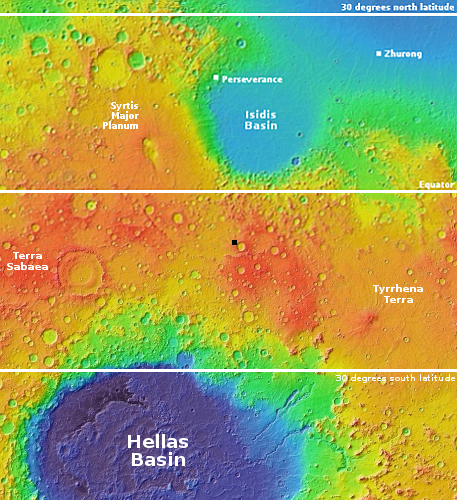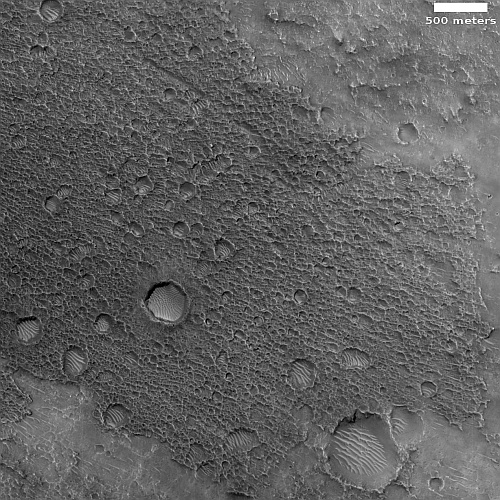Sponge terrain on Mars
Cool image time! The picture to the right, rotated, cropped, reduced, and sharpened to post here, was taken on January 11, 2023 by the high resolution camera on Mars Reconnaissnace Orbiter (MRO).
The scientists labeled this picture “Rocky Terrain.” Though this describes the overall sense of the full image, it fails to capture correctly the nature of this patch of ground at the center of the picture. As you can see, this patch of spongelike surface starts and ends abruptly. It appears that it is a layer on top of the surrounding terrain that has also been eroded aggressively since its placement.
The many craters on its surface seem to have come later, though as the crater size diminishes it becomes harder to separate the craters from the sponge holes. Moreover, some of the larger craters are distorted in shape, as if the impact hit material that was viscous and could flow somewhat.
The overview map below gives some context, but only some.

The black dot in the center of the overview map to the right marks the location of this sponge terrain in the dry equatorial regions of Mars’ cratered southern highlands. This location makes sense considering the very dry stony and hard bedrock appearance of the full image.
However, being in the dry equatorial regions does not explain this patch. A look at an image taken by MRO’s context camera on April 27, 2010, giving us a wider view of this region, shows that this patch is isolated and not obviously linked to surrounding surface features. Just north of it however is another sponge patch that seems confined to a circular ridge that might be the remains of an ancient crater now partly eroded away. If so, this patch filled that crater for some reason, and then over time its surface became similarly spongelike.
Both patches have a lot of small craters, though it does not appear the craters had anything to do with creating this sponge terrain.
To summarize, I haven’t the foggiest idea how this terrain formed, though I suspect it is related to some melt process related to impact. Any guesses from my readers?
On Christmas Eve 1968 three Americans became the first humans to visit another world. What they did to celebrate was unexpected and profound, and will be remembered throughout all human history. Genesis: the Story of Apollo 8, Robert Zimmerman's classic history of humanity's first journey to another world, tells that story, and it is now available as both an ebook and an audiobook, both with a foreword by Valerie Anders and a new introduction by Robert Zimmerman.
The print edition can be purchased at Amazon or from any other book seller. If you want an autographed copy the price is $60 for the hardback and $45 for the paperback, plus $8 shipping for each. Go here for purchasing details. The ebook is available everywhere for $5.99 (before discount) at amazon, or direct from my ebook publisher, ebookit. If you buy it from ebookit you don't support the big tech companies and the author gets a bigger cut much sooner.
The audiobook is also available at all these vendors, and is also free with a 30-day trial membership to Audible.
"Not simply about one mission, [Genesis] is also the history of America's quest for the moon... Zimmerman has done a masterful job of tying disparate events together into a solid account of one of America's greatest human triumphs."--San Antonio Express-News
Cool image time! The picture to the right, rotated, cropped, reduced, and sharpened to post here, was taken on January 11, 2023 by the high resolution camera on Mars Reconnaissnace Orbiter (MRO).
The scientists labeled this picture “Rocky Terrain.” Though this describes the overall sense of the full image, it fails to capture correctly the nature of this patch of ground at the center of the picture. As you can see, this patch of spongelike surface starts and ends abruptly. It appears that it is a layer on top of the surrounding terrain that has also been eroded aggressively since its placement.
The many craters on its surface seem to have come later, though as the crater size diminishes it becomes harder to separate the craters from the sponge holes. Moreover, some of the larger craters are distorted in shape, as if the impact hit material that was viscous and could flow somewhat.
The overview map below gives some context, but only some.

The black dot in the center of the overview map to the right marks the location of this sponge terrain in the dry equatorial regions of Mars’ cratered southern highlands. This location makes sense considering the very dry stony and hard bedrock appearance of the full image.
However, being in the dry equatorial regions does not explain this patch. A look at an image taken by MRO’s context camera on April 27, 2010, giving us a wider view of this region, shows that this patch is isolated and not obviously linked to surrounding surface features. Just north of it however is another sponge patch that seems confined to a circular ridge that might be the remains of an ancient crater now partly eroded away. If so, this patch filled that crater for some reason, and then over time its surface became similarly spongelike.
Both patches have a lot of small craters, though it does not appear the craters had anything to do with creating this sponge terrain.
To summarize, I haven’t the foggiest idea how this terrain formed, though I suspect it is related to some melt process related to impact. Any guesses from my readers?
On Christmas Eve 1968 three Americans became the first humans to visit another world. What they did to celebrate was unexpected and profound, and will be remembered throughout all human history. Genesis: the Story of Apollo 8, Robert Zimmerman's classic history of humanity's first journey to another world, tells that story, and it is now available as both an ebook and an audiobook, both with a foreword by Valerie Anders and a new introduction by Robert Zimmerman.
The print edition can be purchased at Amazon or from any other book seller. If you want an autographed copy the price is $60 for the hardback and $45 for the paperback, plus $8 shipping for each. Go here for purchasing details. The ebook is available everywhere for $5.99 (before discount) at amazon, or direct from my ebook publisher, ebookit. If you buy it from ebookit you don't support the big tech companies and the author gets a bigger cut much sooner.
The audiobook is also available at all these vendors, and is also free with a 30-day trial membership to Audible.
"Not simply about one mission, [Genesis] is also the history of America's quest for the moon... Zimmerman has done a masterful job of tying disparate events together into a solid account of one of America's greatest human triumphs."--San Antonio Express-News



The sand dunes in the hexagonal crater toward center left of the cropped image (better viewed in the magnified original MRO/HiRISE image) appear to have taken on an almost perfect standing wave pattern, no doubt generated by this polygonal shape. Mars is an amazing place.
Mr. Zimmerman:
So many of the incredible pictures you post here remind me of snowscapes and icescapes back in my former state of Minnesnowta.
In this instance, the “spongy” terrain looks a lot like a big patch of hard snow that’s been covered with a layer of wind-blown dirt or dust,, which melted slightly in the sun, and then had a bunch of different size snowballs thrown at it while still soft. The variable thickness of the dirt/dust often results in that sort of spongy look.
I don’t know if that same effect is possible on Mars, with CO2 or water ice playing the role of semi-soft snow/ice, but it was the first thing that came to mind.
Once again, thanks for showing us these amazing features..
This is just bizarre.
I really hope that someday humans have a chance to figure all this out.
So many mysteries.
So much wonder.